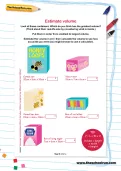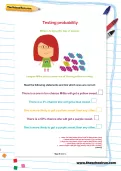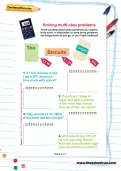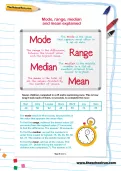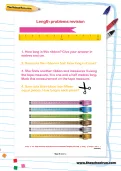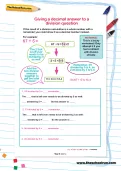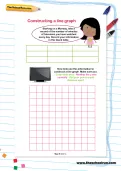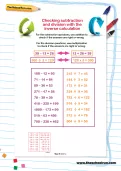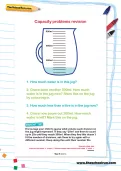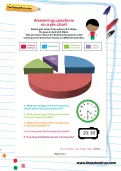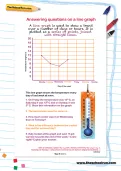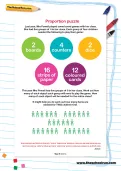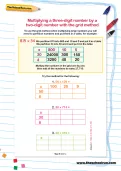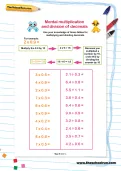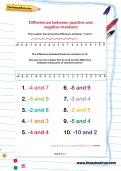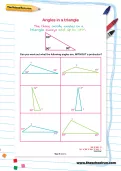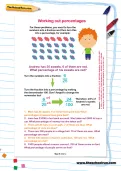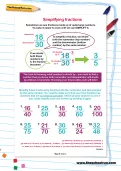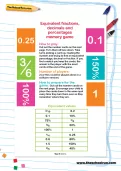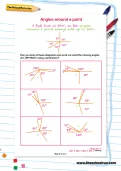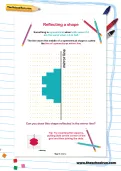Millie is holding a bag of sweets. Imagine Millie picks a sweet out of the bag without looking. Read the following statements and tick which ones are correct.
or
Register to add to your saved resources
Already a subscriber? to view this content.
Think carefully about what operations you need to write down, in what order, to solve these problems. Jot things down as you go, or you’ll get confused!
or
Register to add to your saved resources
Already a subscriber? to view this content.
This KS2 activity was created by a primary school teacher to help your Year 6 child understand maths concepts and build confidence with calculating the mode, range, median or mean.
or
Register to add to your saved resources
Already a subscriber? to view this content.
Let's revise some length problems. How long is this ribbon? Give your answer in metres and cm. How long would it be if it were cut in half?
or
Register to add to your saved resources
Already a subscriber? to view this content.
If the result of a division calculation is a whole number with a remainder you could show it as a decimal number instead. Use these method to solve these really tricky division questions.
or
Register to add to your saved resources
Already a subscriber? to view this content.
Starting on a Monday, take a record of the number of minutes of television you have watched every day. Record your information in this blank table. Now see if you can use this information to construct a line graph.
or
Register to add to your saved resources
Already a subscriber? to view this content.
For these subtraction questions, use addition to check if the answers are right or wrong. For these division questions, use multiplication to check if the answers are right or wrong.
or
Register to add to your saved resources
Can you answer these tricky capacity problems? You can always fill up a measuring jug with water to help.
or
Register to add to your saved resources
Already a subscriber? to view this content.
Daniel gets home from school at 4.30pm. He goes to bed at 8.30pm. This pie chart shows the time Daniel spends in the evening (over these four hours) on different activities. See if you can answer these questions about the pie chart.
or
Register to add to your saved resources
Already a subscriber? to view this content.
A line graph is used to show a trend over a number of days or hours. It is plotted as a series of points, joined with straight lines. Look at this line graph showi the temperature every day of last week at noon and see if you can answer the questions.
or
Register to add to your saved resources
Already a subscriber? to view this content.
Last year, Mrs Powell played some board games with her class. She had five groups of 4 in her class. Each group of four children needed different objects to play the game. This year Mrs Powell has five groups of 6 in her class. Work out how many of each object each group will need to play the game. How many of each object will be needed for the entire class?
or
Register to add to your saved resources
To use the grid method when multiplying large numbers you will need to partition numbers and put them in a table. Use this method to work out these sums.
or
Register to add to your saved resources
Already a subscriber? to view this content.
Use your knowledge of times tables to work out these sums involving multiplying and dividing decimals.
or
Register to add to your saved resources
This positive and negative number line worksheet was created by an experienced teacher to show your child the difference between positive and negative numbers.
Can your child use the number line to work out the difference between these pairs of numbers?
or
Register to add to your saved resources
Already a subscriber? to view this content.
A teacher-created worksheet to support KS2 maths learning and help your Year 6 child practise calculating angles in a triangle.
The three inside angles in a triangle always add up to 180 degrees. Can you work out what the following angles are, WITHOUT a protractor?
or
Register to add to your saved resources
Already a subscriber? to view this content.
For these problems, you need to turn the numbers into a fraction and then turn this into a percentage. See how you get on!
or
Register to add to your saved resources
Already a subscriber? to view this content.
A KS2 numeracy worksheet created by an experienced educator to help your child simplify fractions. Simplify these fractions by dividing both the numerator and denominator by the same number. You need to make sure that your final fraction has numbers that are as small as possible. Check all your answers to see if you could simplify each one further by dividing it again.
or
Register to add to your saved resources
Cut out the number cards and turn them all face down. Take turns picking a card up, reading the number and trying to find an equivalent percentage, decimal or fraction. If you find a match you keep the cards; the winner is the player with the most cards at the end of the game.
or
Register to add to your saved resources
A KS2 maths worksheet created by an experienced teacher to help your primary-school child learn about angles.
A full turn is 360 degrees, so the angles around a point always add up to 360 degrees. Can you look at these diagrams and work out what the missing angles are, WITHOUT using a protractor?
or
Register to add to your saved resources
Already a subscriber? to view this content.
Something is symmetrical when both sides of it are the same when cut in half. The line down the middle of a symmetrical shape is called the line of symmetry or mirror line. Can you draw this shape reflected in the mirror line?
or
Register to add to your saved resources
Already a subscriber? to view this content.

